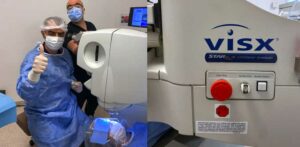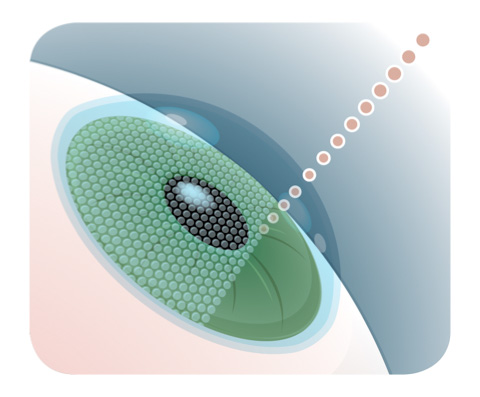LASIK (Laser-Assisted In Situ Keratomileusis) is one of the most popular surgeries on the planet. It has transformed millions of lives and has become a popular procedure for people of all ages. But what is Intralase LASIK? How does it work? And what are the risks and benefits? In this blog post, we will answer all these questions and more. We will also discuss some things to keep in mind before you undergo Intralase LASIK surgery so that you have the best possible experience.
Contents
What is Intralase LASIK?

Intralase LASIK is a type of laser eye surgery that uses a laser to correct your vision. The surgery is performed by inserting a blade into your eye and using it to cut through the cornea, allowing the surgeon to correct your vision. Intralase LASIK is one of the newer types of LASIK surgery and is gaining in popularity because it has some advantages over other types of LASIK surgery.
One advantage of Intralase LASIK is that it can be performed on people who have moderate to severe myopia, which is when your vision is too close or too far away from normal. In contrast, other types of LASIK require someone who has perfect sight to have the procedure done. Intralase Lasik also has minimal side effects than other types of LASIK surgery and results in less vision loss than traditional LASIK surgery.
Another advantage of Intralase LASIK is that it can be done on both eyes at once. This makes it a faster and more effective option than other types of LASIK surgery, which require you to have one eye treated first before having the procedure done on the other eye.
How Does Intralase LASIK Work?
The first step of the process is to create a corneal flap, which will be used throughout the procedure. This is done using Intralase, an advanced type of laser eye surgery technology that uses femtosecond laser pulses to create a precise, thin flap in your cornea with little or no discomfort.
Once the flap has been created, it is folded back to expose the inner part of your cornea. The doctor then uses another type of laser – usually an excimer laser – to reshape your cornea and correct any refractive errors you may have. Finally, after this reshaping process is completed, the corneal flap is replaced, allowing your cornea to heal and complete the procedure.
The next step of the Intralase LASIK process is the recovery period. During this time, you may experience some mild discomfort or blurriness in your vision, but these effects should subside over a few days to weeks.
In most cases, patients can return to their everyday activities within 24 hours without feeling any side effects. It’s also important to note that during the recovery period, it’s important to avoid rubbing your eyes and use lubricating eye drops as directed by your doctor.
The final step of Intralase LASIK is follow-up care. Your doctor will likely conduct periodic check-ups for at least a year after the procedure to ensure that everything is healing correctly and that your vision is returning to normal.
The Risks of Intralase LASIK

There are many risks associated with Intralase LASIK surgery, which is why it is important to discuss all of them with a qualified doctor before considering the procedure. Some of the key risks include:
1. Eye irritation and redness: Intralase LASIK can cause eye irritation and redness, which can last for several days after surgery. This can be caused by the LASIK laser cutting into your eye surface, or by the medications that are typically prescribed following LASIK surgery.
2. Inability to see in bright light: One of the biggest concerns surrounding Intralase LASIK is that it may not be successful in correcting your vision in bright light. This means that you may still require glasses or contacts to see adequately in direct sunlight or other brightly lit environments.
3. Poor vision after Lasik surgery: According to some studies, up to 30 percent of patients who have undergone Intralase Lasik report significant visual problems six months after surgery. These problems may include decreased vision, glare, halos around objects, and poor contrast sensitivity (the ability to see differences between light and dark). If you experience any of these issues following your procedure, speak with your doctor as soon as possible.
5. Cataracts: One of the major risks associated with Intralase LASIK is the development of cataracts. This condition occurs when the natural lenses in your eyes become cloudy and eventually fail. While cataracts can be successfully treated with surgery, they can significantly reduce your vision and often require extensive care and medication. If you are concerned about the potential development of cataracts after Lasik surgery, speak with your doctor about taking steps to prevent this from happening.
What Are The Benefits of Intralase LASIK?
In total, LASIK surgery may offer some major benefits over time. These benefits can include:
1. Greater Quality of Life
Many people who have undergone LASIK surgery say that it has made a significant improvement in their quality of life. In particular, many find that their eyesight is now better than before and that they no longer need to wear glasses or contact lenses.
2. Reduced Eye Care Costs
Another common benefit of LASIK surgery is that it can often save people money on their eye care costs in the long run. For example, people who have LASIK surgery typically no longer need to use eyeglasses or contact lenses, which can save them a great deal of money each year.
3. Improved Vision
Lasik patients typically report improved vision after the procedure. This is likely because LASIK removes most or all of the uncorrected errors in your eyesight – giving you clear, crisp vision without having to wear corrective lenses or glasses.
4. Less Stress Over Your Eyesight
For many people, undergoing LASIK surgery is a relief from the stress and anxiety associated with having poor eyesight. Many feel confident and happy with their new vision, free from the worries of not being able to see properly on important occasions like interviews or meeting new friends.
Cost of Intralase LASIK

The cost of Intralase LASIK treatment can vary depending on the specific procedure you choose, your geographic location, and other factors. However, it is generally considered to be more expensive than traditional LASIK because of its high accuracy rate and safety profile. Intralase technology eliminates the need for a mechanical blade and uses laser energy instead to create a precise corneal flap before reshaping the eye.
The cost of Intralase LASIK can also depend on where you live and the clinic or hospital you choose. For example, if you choose an advanced center with highly qualified surgeons using state-of-the-art techniques, then your cost will likely be higher than going to a less experienced provider. In addition, some insurance companies may cover a portion of the cost, so it is important to check with your provider for eligibility.
Although Intralase LASIK can be more costly in the short term, the long-term benefits of a better visual outcome and improved safety profile make it an attractive option for many patients. Ultimately, if you are considering this procedure, it is best to consult with your eye doctor and discuss all available options to determine what choice is right for you.
Recovery Process after Intralase LASIK

Intralase LASIK is a newer, more advanced type of Lasik surgery. It uses a laser to correct your vision instead of a blade as with traditional Lasik surgery. The recovery process after Intralase LASIK is typically faster and easier than with other types of Lasik surgery, but there are still some steps you need to take to ensure a successful outcome.
Immediately following the surgery, you will be taken to the post-operative area where you will be given pain medication and instructions on how to care for your eyes. You will also be given instructions on how to use your medications and glasses.
Most patients can go home the same day as their Intralase LASIK procedure, but some may require overnight observation due to the severity of their cases. Make sure to ask your doctor if you should stay overnight following your procedure.
The most important thing you can do during the postoperative period is to avoid any eye contact or activity that could cause discomfort or further damage to your vision. Keep all medications as directed and make sure to drink plenty of fluids so that your body can flush out any toxins from the operation. You should also avoid strenuous activity for at least two weeks following your LASIK procedure.
In general, most people experience good vision following Intralase LASIK surgery. However, as with any surgery, there is a chance that you may experience some temporary issues such as reduced vision or glare. If you experience any of these issues, please call your doctor immediately.
Conclusion
Intralase LASIK is a newer type of laser-assisted in situ keratomileuses (LASIK) that has some advantages over traditional LASIK surgery. It can be performed on people with moderate to severe myopia and has minimal side effects. The risks associated with Intralase LASIK include eye irritation and redness, the inability to see in bright light, poor vision after LASIK surgery, and risks associated with complications
If you’re considering Intralase LASIK, knowing a little bit about the procedure can help make the decision easier. In this article, we’ll go over everything you need to know about Intralase LASIK, including its benefits and risks. If you’re ready to take the plunge and schedule your surgery, be sure to read through this guide before doing anything else!
Lasik surgery is a safe 10-minute procedure to help you get rid of glasses. MantraCare offers the most advanced LASIK options. If you have any questions on LASIK surgery feel free to reach out to us at +91-9711116605.
